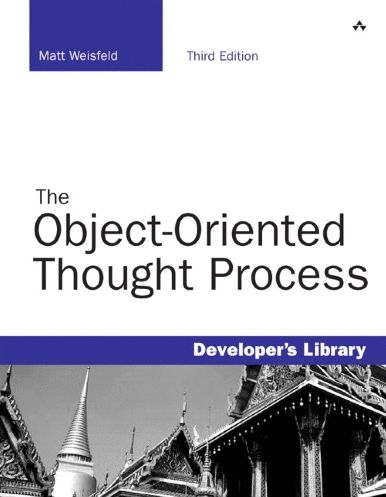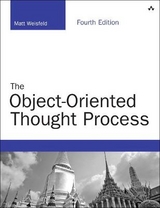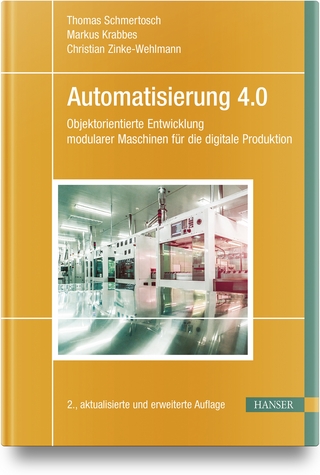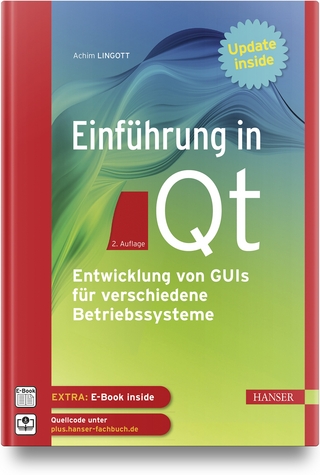
The Object-Oriented Thought Process
Addison-Wesley Educational Publishers Inc (Verlag)
978-0-672-33016-2 (ISBN)
- Titel erscheint in neuer Auflage
- Artikel merken
Third Edition
Matt Weisfeld
An introduction to object-oriented concepts for developers looking to master modern application practices.
Object-oriented programming (OOP) is the foundation of modern programming languages, including C++, Java, C#, and Visual Basic .NET. By designing with objects rather than treating the code and data as separate entities, OOP allows objects to fully utilize other objects’ services as well as inherit their functionality. OOP promotes code portability and reuse, but requires a shift in thinking to be fully understood. Before jumping into the world of object-oriented programming languages, you must first master The Object-Oriented Thought Process.
Written by a developer for developers who want to make the leap to object-oriented technologies as well as managers who simply want to understand what they are managing, The Object-Oriented Thought Process provides a solution-oriented approach to object-oriented programming. Readers will learn to understand object-oriented design with inheritance or composition, object aggregation and association, and the difference between interfaces and implementations. Readers will also become more efficient and better thinkers in terms of object-oriented development.
This revised edition focuses on interoperability across various technologies, primarily using XML as the communication mechanism. A more detailed focus is placed on how business objects operate over networks, including client/server architectures and web services.
“Programmers who aim to create high quality software–as all programmers should–must learn the varied subtleties of the familiar yet not so familiar beasts called objects and classes. Doing so entails careful study of books such as Matt Weisfeld’s The Object-Oriented Thought Process.”
–Bill McCarty, author of Java Distributed Objects, and Object-Oriented Design in Java
Matt Weisfeld is an associate professor in business and technology at Cuyahoga Community College in Cleveland, Ohio. He has more than 20 years of experience as a professional software developer, project manager, and corporate trainer using C++, Smalltalk, .NET, and Java. He holds a BS in systems analysis, an MS in computer science, and an MBA in project management. Weisfeld has published many articles in major computer trade magazines and professional journals.
Matt Weisfeld is an associate professor in business & technology at Cuyahoga Community College (Tri-C) in Cleveland, Ohio.A member of the information technology faculty, he focuses on programming, web development, and entrepreneurship. Prior to joining Tri-C,Weisfeld spent 20 years in the information technology industry gaining experience in software development, project management, small business management, corporate training, and part-time teaching. He holds an MS in computer science and an MBA in project management. Besides the first two editions of The Object-Oriented Thought Process, he has published two other computer books and articles in magazines and journals such as developer.com, Dr. Dobb’s Journal, The C/C++ Users Journal, Software Development Magazine, Java Report, and the international journal Project Management.
Introduction 1
1 Introduction to Object-Oriented Concepts 5
Procedural Versus OO Programming 6
Moving from Procedural to Object-Oriented Development 9
Procedural Programming 9
OO Programming 10
What Exactly Is an Object? 10
Object Data 10
Object Behaviors 11
What Exactly Is a Class? 14
Classes Are Object Templates 15
Attributes 17
Methods 17
Messages 17
Using UML to Model a Class Diagram 18
Encapsulation and Data Hiding 19
Interfaces 19
Implementations 20
A Real-World Example of the Interface/Implementation Paradigm 20
A Model of the Interface/Implementation Paradigm 21
Inheritance 22
Superclasses and Subclasses 23
Abstraction 23
Is-a Relationships 25
Polymorphism 25
Composition 28
Abstraction 29
Has-a Relationships 29
Conclusion 29
Example Code Used in This Chapter 30
2 How to Think in Terms of Objects 37
Knowing the Difference Between the Interface and the Implementation 38
The Interface 40
The Implementation 40
An Interface/Implementation Example 41
Using Abstract Thinking When Designing Interfaces 45
Giving the User the Minimal Interface Possible 47
Determining the Users 48
Object Behavior 48
Environmental Constraints 48
Identifying the Public Interfaces 49
Identifying the Implementation 50
Conclusion 50
References 51
3 Advanced Object-Oriented Concepts 53
Constructors 53
The Default Constructor 54
When Is a Constructor Called? 54
What’s Inside a Constructor? 54
The Default Constructor 54
Using Multiple Constructors 55
The Design of Constructors 59
Error Handling 60
Ignoring the Problem 60
Checking for Problems and Aborting the Application 60
Checking for Problems and Attempting to Recover 61
Throwing an Exception 61
The Concept of Scope 63
Local Attributes 64
Object Attributes 65
Class Attributes 67
Operator Overloading 68
Multiple Inheritance 69
Object Operations 70
Conclusion 71
References 71
Example Code Used in This Chapter 72
4 The Anatomy of a Class 75
The Name of the Class 75
Comments 77
Attributes 77
Constructors 79
Accessors 80
Public Interface Methods 83
Private Implementation Methods 83
Conclusion 84
References 84
Example Code Used in This Chapter 84
5 Class Design Guidelines 87
Modeling Real World Systems 87
Identifying the Public Interfaces 88
The Minimum Public Interface 88
Hiding the Implementation 89
Designing Robust Constructors (and Perhaps Destructors) 89
Designing Error Handling into a Class 90
Documenting a Class and Using Comments 91
Building Objects with the Intent to Cooperate 91
Designing with Reuse in Mind 91
Documenting a Class and Using Comments 91
Designing with Extensibility in Mind 92
Making Names Descriptive 92
Abstracting Out Nonportable Code 93
Providing a Way to Copy and Compare Objects 93
Keeping the Scope as Small as Possible 94
A Class Should Be Responsible for Itself 95
Designing with Maintainability in Mind 96
Using Iteration 97
Testing the Interface 97
Using Object Persistence 99
Serializing and Marshaling Objects 100
Conclusion 100
References 101
Example Code Used in This Chapter 101
6 Designing with Objects 103
Design Guidelines 103
Performing the Proper Analysis 107
Developing a Statement of Work 107
Gathering the Requirements 107
Developing a Prototype of the User Interface 108
Identifying the Classes 108
Determining the Responsibilities of Each Class 108
Determining How the Classes Collaborate with Each Other 109
Creating a Class Model to Describe the System 109
Case Study: A Blackjack Example 109
Using CRC Cards 111
Identifying the Blackjack Classes 112
Identifying the Classes’ Responsibilities 115
UML Use-Cases: Identifying the Collaborations 120
First Pass at CRC Cards 124
UML Class Diagrams: The Object Model 126
Prototyping the User Interface 127
Conclusion 127
References 128
7 Mastering Inheritance and Composition 129
Reusing Objects 129
Inheritance 130
Generalization and Specialization 133
Design Decisions 134
Composition 135
Representing Composition with UML 136
Why Encapsulation Is Fundamental to OO 138
How Inheritance Weakens Encapsulation 139
A Detailed Example of Polymorphism 141
Object Responsibility 141
Conclusion 145
References 146
Example Code Used in This Chapter 146
8 Frameworks and Reuse: Designing with Interfaces and Abstract Classes 151
Code: To Reuse or Not to Reuse? 151
What Is a Framework? 152
What Is a Contract? 153
Abstract Classes 154
Interfaces 157
Tying It All Together 159
The Compiler Proof 161
Making a Contract 162
System Plug-in-Points 165
An E-Business Example 165
An E-Business Problem 165
The Non-Reuse Approach 166
An E-Business Solution 168
The UML Object Model 168
Conclusion 173
References 173
Example Code Used in This Chapter 173
9 Building Objects 179
Composition Relationships 179
Building in Phases 181
Types of Composition 183
Aggregations 183
Associations 184
Using Associations and Aggregations Together 185
Avoiding Dependencies 186
Cardinality 186
Multiple Object Associations 189
Optional Associations 190
Tying It All Together: An Example 191
Conclusion 192
References 192
10 Creating Object Models with UML 193
What Is UML? 193
The Structure of a Class Diagram 194
Attributes and Methods 196
Attributes 196
Methods 197
Access Designations 197
Inheritance 198
Interfaces 200
Composition 201
Aggregations 201
Associations 201
Cardinality 204
Conclusion 205
References 205
11 Objects and Portable Data: XML 207
Portable Data 207
The Extensible Markup Language (XML) 209
XML Versus HTML 209
XML and Object-Oriented Languages 210
Sharing Data Between Two Companies 211
Validating the Document with the Document Type Definition (DTD) 212
Integrating the DTD into the XML Document 213
Using Cascading Style Sheets 220
Conclusion 223
References 223
12 Persistent Objects: Serialization and Relational Databases 225
Persistent Objects Basics 225
Saving the Object to a Flat File 227
Serializing a File 227
Implementation and Interface Revisited 229
What About the Methods? 231
Using XML in the Serialization Process 231
Writing to a Relational Database 234
Accessing a Relational Database 236
Loading the Driver 238
Making the Connection 238
The SQL Statements 239
Conclusion 242
References 242
Example Code Used in This Chapter 242
13 Objects and the Internet 247
Evolution of Distributed Computing 247
Object-Based Scripting Languages 248
A JavaScript Validation Example 250
Objects in a Web Page 253
JavaScript Objects 254
Web Page Controls 255
Sound Players 257
Movie Players 257
Flash 258
Distributed Objects and the Enterprise 258
The Common Object Request Broker Architecture (CORBA) 259
Web Services Definition 263
Web Services Code 267
Invoice.cs 267
Invoice.vb 268
Conclusion 270
References 270
14 Objects and Client/Server Applications 271
Client/Server Approaches 271
Proprietary Approach 272
Serialized Object Code 272
Client Code 273
Server Code 275
Running the Proprietary Client/Server Example 276
Nonproprietary Approach 278
Object Definition Code 278
Client Code 280
Server Code 281
Running the Nonproprietary Client/Server Example 283
Conclusion 283
References 284
Example Code Used in This Chapter 284
15 Design Patterns 287
Why Design Patterns? 288
Smalltalk’s Model/View/Controller 289
Types of Design Patterns 290
Creational Patterns 291
Structural Patterns 295
Behavioral Patterns 298
Antipatterns 299
Conclusion 300
References 300
Example Code Used in This Chapter 301
Index 309
| Erscheint lt. Verlag | 4.9.2008 |
|---|---|
| Reihe/Serie | Developer's Library |
| Verlagsort | New Jersey |
| Sprache | englisch |
| Maße | 228 x 178 mm |
| Gewicht | 578 g |
| Themenwelt | Mathematik / Informatik ► Informatik ► Programmiersprachen / -werkzeuge |
| Informatik ► Software Entwicklung ► Objektorientierung | |
| Mathematik / Informatik ► Informatik ► Web / Internet | |
| ISBN-10 | 0-672-33016-4 / 0672330164 |
| ISBN-13 | 978-0-672-33016-2 / 9780672330162 |
| Zustand | Neuware |
| Haben Sie eine Frage zum Produkt? |
aus dem Bereich



